The saga concludes, for better or for worse
Star Wars: The Rise of Skywalker concludes this saga of the popular franchise
“Star Wars: The Rise of Skywalker” was released on December 20, marketed as the conclusion to the nine-film saga that began more than 40 years ago. The intended audience was primarily those who had grown up with “Star Wars”, and to see the conclusion to the saga they had grown up with is certainly an enticing offer. That said, the new series appeals to new fans as well, since the sequels may be their first venture into George Lucas’s creation. Spoiler warning, obviously, for Episode 9 as well as “Avengers: Endgame.”
In the film, a year has passed since the events of Episode 8, “Star Wars: The Last Jedi,” and the Resistance has been reduced to a mere splinter cell seeking help from people across the galaxy without success. To make matters worse, the late Emperor Palpatine has broadcast a message of posthumous revenge on the galaxy. Our favorite not-Sith, Kylo Ren (Adam Driver), has taken off on a quest to locate a Sith wayfinder, a GPS of sorts that will lead its user to Exegol, yet another ancestral homeworld of the Sith. Having successfully located the wayfinder without too much hassle, he travels to Exegol. There, Kylo Ren discovers a secret cloning facility where Darth Sidious (Ian McDiarmid) has mysteriously resurrected from the dead through a combination of cloning and “Sith magic.” Palpatine reveals his fleet of hundreds of Star Destroyers, which he tells Kylo Ren could be of his command if he successfully kills Rey (Daisy Ridley), the last Jedi.
The plot from this point consists of Rey, Finn (John Boyega), Poe (Oscar Isaac), Chewbacca (Joonas Suotamo), C-3PO (Anthony Daniels) and BB-8 attempting to locate the second wayfinder, assisted through notes Luke Skywalker (Mark Hamill) left behind in the sacred Jedi notes taken by Rey in the previous film. Along the way, they encounter comrades new and old, such as Lando Calrissian (Billy Dee Williams), Babu Frik (Shirley Henderson) and Zorii Bliss (Keri Russell).
This film’s object of interest is the wayfinder, which will lead its possessor to Exegol if used correctly. However, the steps they take to obtain the wayfinder can be summed up in one sentence. In order to get from Point A to Point B, you need to obtain this object from Point C, but Point C is locked away unless you can do this thing on Point D. The crew travels from planet to planet, trying to find a way to the Sith GPS that will take them where they have to go, completing task after task. However, all of the efforts to get the wayfinder from Point C are proven fruitless once Kylo Ren destroys it, forcing Rey to overpower him in lightsaber combat to take his wayfinder and use that to lead the Resistance to Exegol. More than an hour of the film is spent convincing the audience that the quest to track down the wayfinder will be crucial to the plot, only for it to ultimately amount to nothing.
The primary goal of the film appears to be to attempt to use nostalgia to bring back old fans while attempting to travel in a new thematic direction. Unfortunately, trying to move in two directions at once often results in falling flat on your face. Much like “Star Wars: The Force Awakens” borrowed plot devices from “A New Hope,” “The Rise of Skywalker” borrows them from “Return of the Jedi.” In this case, it would be ‘antagonist faction whose planet-destroying superweapon was obliterated returns with bigger, badder planet-destroying superweapon.” At the same time, it introduces so many new characters and brings back so many familiar faces that the film is full of characters whose only reason for appearing is to either advance the plot or pander to nostalgia. The strategy of combining nostalgia and uniqueness ultimately doesn’t work for “The Rise of Skywalker,” as it creates internal conflict rather than having it stand out among cinematic masterpieces.
As a matter of fact, the film’s climax follows what can only be described as the “Endgame Formula,” in which the heroes have reached their darkest hour against their previously-dead antagonist and their massive army, only for the heroic calvary to come in to save the day. However, the main antagonist gets a power boost by some mystical means and proceeds to attempt to decimate the heroic forces, only to be challenged by the main protagonist. The bad guy says a one-liner (“I am inevitable”/ “I am all the Sith”), to which the hero responds with their own line and kills the bad guy (“I am Iron Man”/ “I am all the Jedi”), thus restoring balance to the universe. “The Rise of Skywalker” not only borrows plot devices from other “Star Wars” films, but other franchises entirely, by films such as the aforementioned “Avengers: Endgame,” and this very much blurs the line between uniqueness and nostalgia.
That isn’t to say the movie was a flawed mess whose only purpose was to move on from its predecessor, however. The special effects used throughout brought a return to form for the sequel trilogy, with intense space battles and close-range dogfights rather than a game of keep-away. There were plenty of callbacks to previous films that old fans would certainly enjoy, such as the inclusion of actors from the original trilogy like Mark Hamill, Harrison Ford and Billy Dee Williams. Carrie Fisher also makes a posthumous appearance in the film through unused footage from 2015’s “Star Wars: The Force Awakens.”
“Star Wars: The Rise of Skywalker” provides the conclusion to the nine-film saga that the fans have been anticipating for more than forty years, and to see this point in the franchise’s history is certainly something no one should miss.












